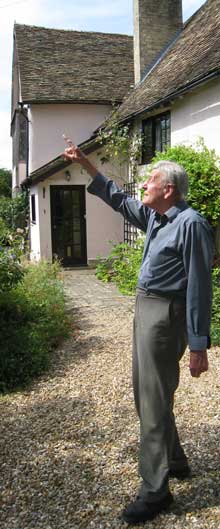|
More Dorniers over Little Eversden The account of the Dornier crash in 1942 (click) triggered this recollection |
 |
| David Ellis remembers well his 16th birthday in 1940. It was 8.30 in the morning.
Breakfast was over. It was time to get back out on the farm. A deep
drone and the boom of high explosives punctuated by the sound of machine
gun fire drew the family out on to the driveway of Five Gables Farm.
David looked up and saw , almost overhead, a close formation of about
twelve Dorniers in a cloudless sky flying at around 15000 feet. An "ominous whine" sent the family diving for cover, but no explosion followed it. Reports from the village confirmed David's suspicion that the village was being peppered with empty cartridge cases. There used to be a cottage at the top of Little Eversden High Street called Organ Cottage. It was so named because the rent from the cottage maintained the church organ! It had been thatched but the churchwarden of the day, a certain Mr Ellis (Grandfather), had replaced the worn-out thatch with corrugated iron. The occupants on 31st August 1940 were more than alarmed when a cartridge case clattered on the roof. The bombing raid was something of a botched attempt. A Cambridgeshire County Council booklet produced just after the war entitled "An Historical Account of Air Raid Precautions, 1935-1945" (and quoted in "One Hurricane - One Raid" - see below) describes the raid: The bombs "...started at Manor Farm, Fowlmere, close to the farm buildings (to which no appreciable damage was done). About 50 were dropped in a clover field. ... At the bottom of the field is a shed in which men working on water-cress beds were having breakfast. Several bombs fell quite close, and a glass window in the shed was broken; and the galvanised iron roof was slightly damaged. The men were not hurt at all. The line of bombs then went through stubble, orchard, and grassland, until it reached the A10. |
 |
|
One bomb fell on the western grass verge about 100 yards south of the Fowlmere turn. The side of the road was damaged , but one-way traffic was always practicable. The road was reopened fully by Saturday evening. There was a house within 50 yards of the point where the bomb fell, which suffered no damage. The line of bombs continued across stubble to the Hitchen- Cambridge railway, close to the Cam Blue Lias Cement Works about halfway between Meldreth and Shepreth stations. One bomb fell on each side of the railway within a few yards, but no damage was done. The line of bombs continued over a grass field, and through an orchard to the Meldreth-Shepreth road, one bomb fell in the middle of the road close to a small bridge which carried the road over the stream dividing the Meldreth and Shepreth parishes. The road was rendered impassable, but the bridge was not damaged. The blast appeared to work backwards. A lump of concrete was thrown a considerable distance southwards, but a cottage that was within 50 yards obliquely north, suffered no damage. The road was reopened to traffic on Saturday evening. The line then continued close to the same stream until it entered the river, and there were a few bombs north of the river in Barrington parish. A number of Incendiary Bombs were dropped at the same time, but these fell not so regularly, and more to the east. Some fell in Fowlmere, others in various parts of Shepreth, and some on Barrington Green. The exact number is not known. A few of the High Explosive bombs did not explode on landing" So on David's 16th birthday The Eversdens escaped being bombarded by more than just a few cartridge cases; the supply of water-cress from Fowlmere was uninterrupted; traffic on the A10 continued to flow; the cows at Five Gables Farm got milked as usual. But the world was changing. The sixteen-year-old David Ellis's world, in particular, was about to be transformed. He was studying for the Aircraft Apprentice examination. He won his place at Cranwell in 1941 and embarked on a two-year course in radio. Exciting times lay ahead. The incident over The Eversdens was just a small drama in a bleak day. The Dorniers, probably about thirty of them altogether, had set out to destroy the fighter bases at Debden and Duxford. They were guarded by squadrons of Messerschmidts. Debden suffered some damage to the airfield. Duxford escaped this raid completely. Bombs were jettisoned over a wide area from Cambridge to Chelmsford. One civilian died. One Dornier was lost and six Messerschmidts. One crewman died. The RAF lost eleven fighter aeroplanes. Three pilots died and five were incapacitated. By 10.00am the same morning the next raid was crossing the coast at Folkestone. Hurricanes and Spitfires were scrambled to intercept. Two more raids followed. Fighter Command lost thirty-nine aircraft and fourteen pilots that day. It was Fighter Command's highest one-day loss of the Battle of Britain. The whole story is chronicled in "One Hurricane - One Raid" by Geoff Rayner, published by Airlife Publishing Ltd in 1990. David Ellis contributed to the account relating to The Eversdens but disputed minor details. The account above is how he saw it. "One Hurricane - One Raid" is a "must read" for all wartime aeroplane buffs. David Farnell |
|